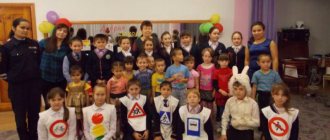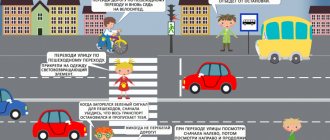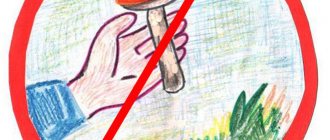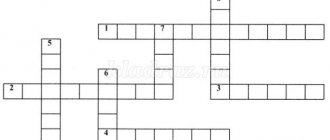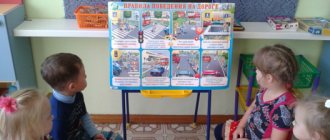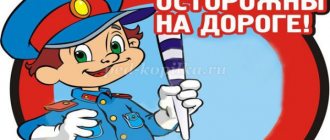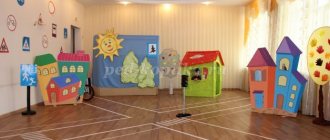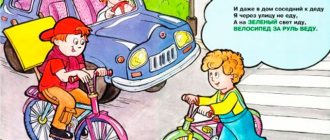Quiz for parents on traffic rules
(Before leaving the sidewalk onto the roadway, you need to make sure that there are no cars nearby, and before you start crossing, you need to look to the left and make sure it’s safe, reach the middle, look to the right and finish the transition).
10. Why outside the city should we go towards moving traffic.
(This is so that people can clearly see oncoming cars and can step aside in advance).
11. Why is it advisable to be at some distance from the roadway at transport stops, watching for approaching vehicles, especially in wet weather?
(If the site is wet or slippery, you can slip and get hit by a vehicle. If the roadway is slippery, cars can skid onto the site, sidewalk or shoulder, and be covered in mud).
12.
How should an adult with a child get on and off public transport?
(When boarding, the adult must first help the child enter, and then enter himself. When exiting, the adult must first exit, and be sure to immediately take the child by the hand).
13. Why is it not recommended to linger in a vehicle when the doors are open?
(The driver, seeing that no one is getting out, will turn on the mechanism that closes the doors. The passenger will rush to the door and may get stuck in them, which can lead to serious consequences).
14.What is the danger for a pedestrian when one car is ahead of another?
(In the shortest seconds of overtaking, neither the pedestrian nor the driver of the overtaking car sees each other and cannot take safety measures in advance. The pedestrian must, after crossing each lane, make sure that further movement is safe).
15. How should people who are in wheelchairs or driving a moped or motorcycle move?
(They must follow the direction of travel of vehicles).
16. Is it allowed to carry passengers by bicycle?
(Children under 7 years of age are allowed to travel in a specially equipped seat)
17. Is it safe to start crossing when the traffic light is flashing green?
(It is unsafe, since a car may approach the intersection, the driver of which will try to cross the intersection on the move).
18. How should cyclists move on the road?
(“Bicycles should only travel in the rightmost lane, single file, as far to the right as possible. Riding on the side of the road is permitted if this does not interfere with pedestrians.”)
19. In the event of a breakdown, how should cyclists move on the roadway outside populated areas?
(“Outside populated areas, when moving along the roadway, pedestrians must go towards the movement of vehicles. Persons moving in wheelchairs without a motor, driving a motorcycle, moped, bicycle, in these cases must follow the direction of movement of vehicles”).
Rules of conduct on the road
A traffic rules quiz for schoolchildren should form stable concepts in this area. What is the essence of the concept of traffic rules and their necessity? Rules of conduct on the road are instructions for the actions of all road users. Ignorance of basic nuances leads to road accidents, injuries and deaths.
Everyone should know the answers to the following questions:
- What are the main sections of traffic rules? Responsibilities and rights of passengers, pedestrians and drivers, requirements for cyclists, speed, overtaking rules. Traffic regulation, stopping, parking, road signs, and road markings should also be studied.
- What kind of vehicle traffic is established on the territory of the former Soviet Union? Right-hand traffic of vehicles.
- On which side are vehicles overtaken? Overtaking is done on the left.
The proposed traffic rules quiz for schoolchildren motivates the need for students to study the rules of conduct.
Road users. What should a child know?
The traffic rules quiz at school should form a responsible attitude towards the rights and responsibilities of road users.
It is important to emphasize that everyone has their rights and responsibilities. And overall safety depends on how responsibly everyone follows the rules.
Questions might include:
- Name road users (all persons using roads: pedestrians, drivers, passengers, cyclists).
- Name the main responsibilities of pedestrians (movement in specially designated places: sidewalks, pedestrian paths, above-ground and underground pedestrian crossings, crossings equipped with traffic lights).
- Name the main responsibilities of drivers (availability of documents confirming the right to drive, good condition of transport, cleanliness of the roadway, informing the relevant services about problems on the roads, responsible attitude towards the lives of others).
- What are the main responsibilities of passengers (boarding and disembarking at stops, wearing seat belts in cars).
- What are the main responsibilities of cyclists (carrying goods that do not pose a threat to traffic, holding on to the handlebars of the bicycle and keeping your feet on the pedals).
Road and cyclists
A separate issue that needs to be discussed among schoolchildren is compliance with traffic rules by persons driving bicycles and mopeds, since most of the children drive one of these vehicles.
A traffic rules quiz may include the following questions:
- Age of owners of mopeds and bicycles, from which it is permitted to drive these vehicles on the roadway? (For mopeds – 16 years, bicycles – 14 years).
- What categories of passengers can a person driving a moped or bicycle transport? (Children under seven years of age).
- Rules for movement on sidewalks and pedestrian paths for persons driving a moped or bicycle? Children are allowed to travel on sidewalks and pedestrian paths on children's bicycles under the supervision of adults.
- Equipment requirements for mopeds and bicycles? Availability of lighting, sound signal, reflectors (white in front, orange on the side, red in the back), working brakes.
Rules for public transport passengers
An important topic is consideration of the rules of conduct for passengers in public transport.
A traffic rules quiz may include the following questions:
- What places are available to wait for public transport? Landing areas are equipped to wait for public transport; if they are not available, a sidewalk or the side of the road is used.
- Rules for boarding and disembarking passengers on trams, trolleybuses, and buses. Boarding is carried out through the rear doors, and disembarking is through the front doors. Preferential categories of the population can enter through the front doors.
- Which direction should a passenger exiting a tram look in order to cross the road safely? You must look to the right to make sure there is no other traffic.
- Is it possible for a passenger exiting public transport to walk around in front or behind it? Bypassing vehicles is dangerous to life; crossing is possible only in the designated place.
- Is it possible for a passenger to distract a public transport driver while driving? Distracting the driver while driving is strictly prohibited.
Traffic signs
Traffic signs are images of conventional symbols that are installed along the road in order to provide road users with certain information.
The traffic signs quiz will allow you to remember the main categories of signs and the meaning of the basic ones. The competition can be held in the form of a game.
A traffic rules quiz may include the following questions:
- Name the main categories of road signs. The main categories of road signs include: warning, prohibitory, prescriptive, informational, priority signs, service signs, signs for road signs.
- What do the warning signs mean? Traffic warning signs indicate danger on the road and the need to take certain safety measures. First of all, such traffic signs include signs warning about an unregulated pedestrian crossing near populated areas, about the possible appearance of children on the road due to the close location of childcare facilities, about a section of the road where traffic is regulated by a traffic light.
- What do prohibiting traffic signs mean? The purpose of prohibitory signs is to introduce or cancel any restrictions on movement. For example, signs prohibiting the movement of bicycles, horse-drawn carts (sleighs), entry, and stopping.
- What do the prescriptive signs mean? Such signs regulate mandatory directions of movement and their features. Such signs are usually indicated by white arrows in different directions on a blue background: movement only straight ahead, left, right, etc.
- What do traffic information signs mean? These signs indicate specific driving conditions. Such signs include: a pedestrian crossing sign, an underground pedestrian crossing sign, a parking lot, a distance indicator, the beginning and end of a populated area.
- What do the priority signs mean? These signs determine the order of maneuvers on the road.
- What do service marks mean? Service signs indicate nearby infrastructure: cafe, hospital, toilet, recreation area, beach or swimming pool.
- Purpose of plates for road signs. The signs clarify the content of the signs in addition to which they are placed.
The most important element for consolidating knowledge of traffic rules is a game. We offer several options for topics for those who are interested in the traffic rules quiz game. Children will find this kind of pastime interesting and educational.
Transport
A quiz on the topic “Road Traffic”, of course, should separately consider the types of urban transport, the features of its movement, the rules of conduct for passengers and drivers.
Questions could be:
- Name the types of urban transport. Answer: passenger, cargo, special.
- Purpose of passenger transport. Its subspecies. Answer: Passenger transport is designed to transport passengers. The main passenger vehicles include car, bus, trolleybus, tram, and metro.
- Why do we need freight transport? Its subspecies. Answer: Freight transport is designed to transport goods. The main subtypes of freight transport are flatbed trucks, vans, tractors, refrigerators, tanks, dump trucks, and platforms.
- Purpose of special transport. Its subspecies. Answer: special transport is transport that ensures the implementation of the functions of medical care, law enforcement agencies, rescuers, and public utilities. Subtypes of special transport include law enforcement vehicles, ambulances; snow removal equipment, watering machines, military vehicles, fire trucks.
This “Traffic Experts” quiz will help you consolidate your knowledge about transport.
Questionnaire for parents on traffic rules
Questionnaire for parents
“Studying parents’ attitudes towards the need to teach children traffic rules”
1. Do you consider the problem of child safety on the roads important?
— Yes;
— No;
— I find it difficult to answer.
2. What work is being done in your family to familiarize children with the Rules of the Road?
— conversations with the child about his safety on the road;
— reading children's literature about traffic rules;
— watching cartoons about the rules of safe behavior on the road;
— practical skills of behavior on the road;
— in-depth study of traffic rules.
3. How often do you tell your child about the need to follow traffic rules?
- daily
- Sometimes
- very rarely
- don’t talk about this topic
— other answers__________________________________________
4. Are you ready to participate with your children in educational activities on the prevention of child road traffic injuries in our kindergarten?
— Yes;
— No;
— I find it difficult to answer.
5. Who does your child usually walk with in the yard?
— alone, I watch from the window;
— we walk together: the child plays, I sit on the bench and talk with other parents;
— I am next to the child, I control the situation.
6. Do you teach your child the rules of conduct in public transport?
— Yes;
— No.
7. What forms of kindergarten work with parents do you consider the most productive to help familiarize children with the Rules of the Road:
— organizing an exhibition of literature on this topic;
— holding lectures for parents;
— meetings with a traffic police inspector;
— holding joint events with children (holidays, sports activities, etc.);
— posting information in the corner for parents;
— individual conversations;
— parent meetings on this topic.
8. In your opinion, at what level is work being done to familiarize children with the Rules of the Road in our kindergarten:
— on high;
- on average;
- on low.
Thank you for your sincere answers!
Questionnaire for parents on traffic rules “Me and my child on the city streets”
1. Your child knows:
- name of the city in which he lives; your home address
— name of the street, microdistrict; house number, phone number
- your home address is not complete
2. You and your child get home from kindergarten:
- on foot
- on transport
3. If you have to walk, then you and your child:
— cross the road only on the pedestrian path, guided by the green traffic light;
— cross the road on a pedestrian path if there are no cars, and do not look at the traffic light;
- cross the road where you feel comfortable
4. Who will teach the child to follow the traffic rules:
- kindergarten
- the parents themselves
- grandmother grandfather
5. How often do you tell your child about the need to obey traffic rules?
- daily
- Sometimes
- very rarely
- we don’t talk about this topic
6. Does your child know traffic signs and can tell what they mean?
- Yes
- No
- I find it difficult to answer
7. How does your child behave in city transport?
— my child stands calmly at the bus stop and gets on the bus with the adults; does not make noise; if possible, sit on an empty seat; does not litter in the cabin
— my child runs and jumps at the bus stop; sits at any door without being guided by an adult; makes his way quickly to an empty seat, pushing aside other passengers; talking loudly in the vehicle
8. Do you follow traffic rules yourself?
- I always comply
- not always
- I don’t comply
9. Do you break the Rules when you walk with your child?
- No
- sometimes happens when we are in a hurry
- I don’t pay attention to traffic lights and cars
10. Do you think that the efforts of preschool teachers to familiarize children with the rules of safe behavior on the street:
— will be effective only with your support
- will be effective without any support from you
- are ineffective, since only parents can teach safe behavior on the street.
Thank you for your sincere answers!
Pedestrian traffic
Another traffic rules quiz with answers:
- Who is a pedestrian? A pedestrian is a person who moves on foot.
- What areas are designated for pedestrian traffic? For the movement of pedestrians, a sidewalk and a pedestrian path are provided; if there is no zone for pedestrian movement, movement along the roadway is possible, but always in the direction opposite to the traffic flow.
- What is a sidewalk for? For pedestrian traffic.
- What is a roadway? Part of the road for transport.
- Types of roads? Roads are one-way or two-way, with left-hand and right-hand traffic directions.
- Rules for crossing the street as a pedestrian? A pedestrian must cross the street in places where there is a traffic light at a green traffic light sign, at a pedestrian crossing, underpass, at a traffic controller sign.
- What is the purpose of a traffic light? The traffic light is designed to regulate the movement of vehicles and pedestrians.
- Crossroads is...? A crossroads is an intersection of roads.
